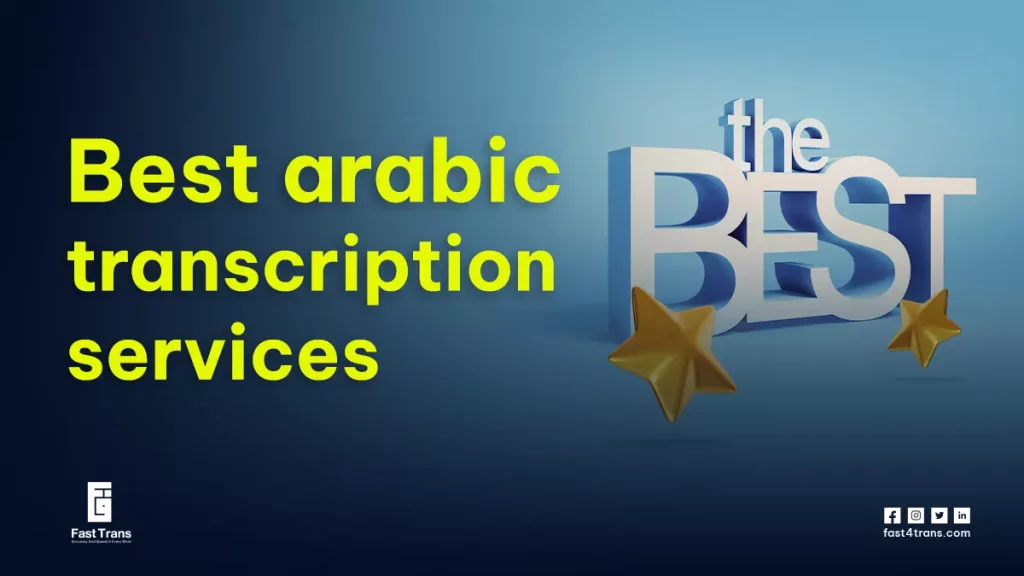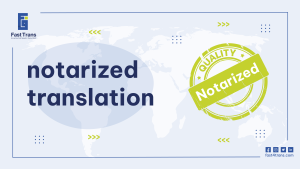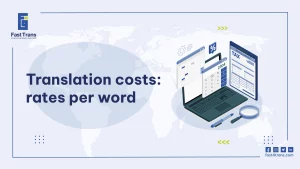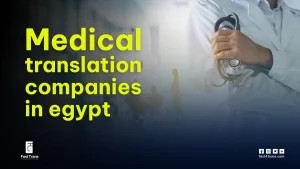This Arabic Transcription Guide explaining transcription which is the process of converting spoken Arabic into written form, ensuring the original content is preserved. It plays a crucial role in breaking language barriers, supporting language learners, and enabling businesses, educators, and researchers to engage with Arabic-speaking audiences.
Unlike transliteration or translation, transcription focuses on accuracy, whether through verbatim or intelligent methods, making it vital for fields like legal, medical, and media. Beyond enhancing communication, it also supports AI, improves accessibility for the hearing impaired, and helps with creating subtitles, translations, and voice-overs for seamless global interactions.
What is Arabic transcription?
Arabic transcription is the process of converting spoken Arabic sounds or written Arabic text into a different writing system, most commonly the Latin alphabet, or sometimes another script like Hebrew or Cyrillic. The primary goal is to represent the pronunciation of Arabic words or phrases using the phonetic conventions of the target script.
This is crucial for various applications, including language learning, transliterating names and places, and in computational linguistics for tasks like speech recognition. Because Arabic has sounds that don’t map perfectly to Latin letters or the emphatic consonants), transcription systems often use diacritics (special marks above or below letters) or combinations of letters to approximate these phonemes, leading to various established standards like the ALA-LC Romanization or the ISO 233 system.
What is Arabic video transcription?
Arabic video transcription is the process of converting the spoken words in an Arabic video—whether it’s from a lecture, news report, interview, or any other visual media—into written text. This process is essential for accessibility, allowing the hearing-impaired to follow the content, and for content creators to generate subtitles or closed captions.
It can be done manually by a human transcriber, which often yields high accuracy due to the complexities of the Arabic language (including its various dialects and rich morphology), or increasingly through Automatic Speech Recognition (ASR) technology, which utilizes sophisticated algorithms trained on large corpora of Arabic speech data to achieve faster, though sometimes less precise, transcription results.
What is Arabic audio transcription?
Arabic audio transcription is the process of converting spoken Arabic language from an audio or video recording into written text. This is a specialized task due to the complexities of the Arabic language, which include its rich morphology, various dialects (Modern Standard Arabic vs. regional dialects like Egyptian, Levantine, or Maghrebi), and the use of diacritics (vowel markings) that are often omitted in written form.
The transcription can be done either manually by a human transcriber or automatically using Automatic Speech Recognition (ASR) technology trained specifically on Arabic speech data. The resulting transcript is crucial for numerous applications, such as creating subtitles, archiving historical recordings, powering search functions for audio content, and facilitating linguistic analysis.
What is the difference between Arabic transcription, transliteration, and translation?
It’s confusing!
And you may find that many people mix them. but we are going to make it simple by knowing the definition of each one.
Transcription:
writing down the same audible content in the same language.
example: If there is a talk between two people and the first one says: كيف حالك؟
It will be transcripted as follows: “كيف حالك؟” in written words.
Transliteration:
converting Arabic script to its Latin counterpart. Transliteration does not give you the meaning of words in another language like translation; rather, it helps you pronounce the Arabic words by writing the sounds of the Arabic word into the English or Latin alphabet.
example:
Arabic word that is the name of the first surah in the holy Quran: الفاتحة
Translation (meaning): The Opening
Transliteration (the sound): Al-Fatiha
Translation:
converting the meaning of written or spoken Arabic content from one language to another
example: “write” in Arabic means “يكتب” and we say يكتب is the Arabic translation of write.
Types of transcription services:
Transcription services can be categorized into different types: Strict verbatim captures every spoken detail, ideal for legal or market research contexts; Intelligent verbatim focuses on clarity and meaning, commonly used in business and medical fields; Edited transcription enhances readability and coherence, suitable for content creation; Phonetic transcription uses symbols to represent pronunciation, aiding language learning.
1. Strict Verbatim Transcription:
In this type of transcription, we write down every word in the audio file as it is, paying attention to every detail, and we include things like:
- Interruptions, stumbles, laughs, noises in the background, and repeats.
- Pauses in speech: “uhms”, “ahs”, “hmms”
Strict verbatim transcription is usually used in:
- legal fields.
- market research.
- Movies scripts.
2. Intelligent Verbatim Transcription:
The transcriber avoids any distracting parts of the audio or video. The purpose of intelligent verbatim transcription is to provide a clear written transfer that is more readable and precise.
This needs a human, clever transcriber, not just a tool. so he can understand, analyze, and reproduce the audible content correctly.
The most important aspect of intelligent verbatim transcription is to keep the meaning and spirit of the spoken speech unchanged, but in a more suitable way for the written form.
Intelligent verbatim transcription is usually used in:
- Businesses.
- Podcasts.
- Meetings and conferences.
- Learning courses.
- Medical field.
3. Edited Transcription:
Here, it’s not about writing the same pronounced words but about writing them in a coherent, brilliant way. So you need to be a transcriptor and editor simultaneously to write free mistakes and well-written pieces of content.
You may have to delete or replace some parts as you need to rewrite the same meaning in different words or change the order of writing.
4. Phonetic transcription:
It is about writing. The phonetic symbols represent how each word is spoken, which is a mix of transcription and transliteration. This kind of transcription is rare and is used to simplify learning new languages.
What are the benefits of Arabic audio transcription?
Arabic audio transcription enhances accessibility and communication, making Arabic content more understandable across various sectors, including business, education, and healthcare. It supports research, language learning, AI development, and content creation, facilitating effective international engagement.
1- Enhance communication:
Arabic transcription eliminates the language barrier, enabling individuals to comprehend and engage with Arabic content effectively.
This is particularly beneficial for businesses seeking to expand into Arabic-speaking markets, educational institutions offering Arabic language programs, and individuals engaged in international collaborations.
2- Better Research and Analysis:
Transcription makes it easier for academics to analyze texts in Arabic by helping them to find major themes, extract information, and obtain a better understanding of the Arabic language and culture. This can be extremely useful for academic study, market analysis, and political analysis.
3- Assist non-Arabs in learning Arabic:
Arabic transcription is a language learning tool that helps non-Arabs learn the language more effectively and enthusiastically. It is highly used for improving pronunciation and teaching phonetics.
4- Improve AI and machine learning models:
Transcription, especially phonetic transcription, is one of the most used tools in linguistics to build more effective machine learning models.
5- Media Videos Subtitling and Captioning:
Arabic transcription is essential for producing subtitles and captions for Arabic media content.
6- Enable disabled individuals with hearing problems:
They can understand and enjoy more video and audio content through reading subtitles.
7- For marketing purposes:
discussion transcription with focus group participants or consumer survey respondents or transcription of the ads to make the selling message clearer and to improve communication through international business dealings.
8- In the medical and legal fields:
Transcription helps in writing down every single step during diagnosis and documenting every step of the legal process
9- Preparing for translation and voice-over:
Transcription and translation are widely used in tandem, with transcription serving as the initial step before the text is translated or voiced over.
What is the best Arabic transcription tool?
Finding the best Arabic transcription tool depends heavily on your specific needs, such as the required accuracy, the complexity of the Arabic dialect (Modern Standard Arabic vs. various vernacular dialects), and whether you need automatic (AI) or human transcription.
Here is a detailed list of some of the top contenders and the features that make them stand out:
1. HappyScribe
HappyScribe is a popular solution offering flexibility, which is crucial for the complexity of the Arabic language.
- Key Feature: Hybrid Model – They offer both Automatic (AI) transcription (fast, lower cost) and Human-Made transcription (slowest, highest cost, but with 99% accuracy).
- Arabic Support: They explicitly mention supporting Arabic and covering accents and regional variations, which is a significant factor in Arabic transcription.
- Workflow: Simple process: Upload the file, select “Arabic,” choose “Machine generated” or “Human made,” and receive the transcript.
- Export Formats: TXT, DOCX, PDF, SRT (great for subtitles), or HTML.
- Collaboration: Offers shared workspaces for team editing and management.
2. Notta
Notta is an AI-first tool known for its speed and incorporation of AI productivity features.
- Key Feature: High AI Accuracy & Summarization – They claim a high accuracy rate of up to 98.86% for high-quality audio, which is impressive for an automated service. It also includes an automatic AI summary of the transcribed file.
- File Compatibility: Highly compatible with numerous audio and video formats (WAV, MP3, MP4, MOV, etc.) and can transcribe directly from a YouTube link.
- Platforms: Available across multiple platforms (Web, iOS, Android).
- Security: Claims strict adherence to GDPR, CPPA, SSL, and APPI standards.
3. Voiser
Voiser positions itself as a high-accuracy, cost-effective, and fast AI solution for multiple languages.
- Key Feature: High Accuracy for Specific Dialects – They boast up to 99% accuracy and specifically list support for Arabic (Egypt), indicating training on specific regional variations.
- Cost-Effectiveness: Highlights its service as much more economical than other transcription services.
- Usability: Features an easy-to-use platform with an AI-supported studio for minor adjustments.
- Language Scope: Supports over 75+ languages, dialects, and accents.
4. Sonix
Sonix is a professional, online AI transcription software recognized for its speed, accuracy, and robust editing features.
- Key Feature: Advanced In-Browser Editor – Their world-class editor allows users to quickly make slight tweaks to the AI-generated transcript, with time-syncing between the audio/video and the text.
- Affordability & Speed: Claims to be accurate, affordable, and fast, often completing transcription in under 10 minutes using the latest Arabic language AI.
- Multitrack Support: Can synthesize multitrack recordings into one transcript with automatic speaker labeling, which significantly improves accuracy.
- Export Options: Excellent format support, including SRT, DOCX, PDF, and plain text.
5. TranscribeMe
TranscribeMe focuses on delivering the highest possible accuracy using a human and hybrid approach.
- Key Feature: Human/Hybrid Model (The Gold Standard) – They utilize a blend of Automatic Speech Recognition (ASR) and a network of crowd-sourced human transcriptionists to achieve 99%+ accuracy. This is ideal for complex, noisy, or dialect-heavy audio.
- Contextual Accuracy: Their “Gold Standard” method focuses on contextual elements, including grammar, speaker identification, and tags for non-verbal noises (like laughter), ensuring a precise transcript.
- Industry Expertise: Offers industry-specific solutions for legal, medical (HIPAA compliant), and market research sectors.
6. ElevenLabs Scribe (Developer-focused)
A high-performance Automatic Speech Recognition (ASR) model often cited in benchmarks, particularly useful for developers or companies integrating ASR into their applications.
- Key Feature: Industry-Leading ASR Accuracy – ElevenLabs Scribe is promoted as one of the most accurate speech-to-text models, outperforming others in various benchmarks. It is designed for developers via a simple API integration.
- Detailed Features: Includes speaker diarization (identifies and labels each speaker), precise word-level timestamps, and dynamic audio tagging (identifying sound events like laughter).
- Arabic Performance: While rated in the “Good” accuracy category (due to the complexity of the language), its use of advanced AI for ASR makes it a powerful option for technical users.
But do you need my opinion?
Try fast-trans!
It’s more accurate and understandable at the lowest cost! And the most important thing is that it is done by humans.
How can fast-trans help you with Arabic transcription?
Arabic transcription makes the Arabic content easily accessible because of:
- the clarity of the written words compared to the spoken ones.
- It’s the first step before audio translation.
We, at Fast-trans have the experts and experience you need to transcribe your materials by humans who understand the purpose of every transcription piece. We have copywriters, translators, linguistics experts, and editors, which means you will enjoy integrated, accurate service.
After the transcription process, we have multiple review phases to ensure that every sentence that is well-heard is well-written.
What Our Customers Say
Since the translation project is theirs, we encourage the clients to discuss every stage of the process.
You can check our clients’ comments for yourself at Google Reviews.
Conclusion
Arabic Transcription Guide involves converting spoken Arabic into a precise written format, maintaining the integrity of the original audio. This meticulous process is essential for creating accessible content across various contexts, including business, education, and media. Unlike transliteration, which focuses on representing Arabic sounds in the Latin script, or translation, which conveys meaning in a different language, transcription stays true to the original language, capturing conversations, speeches, or other audio accurately. From strict verbatim capturing every detail to intelligent verbatim focusing on readability, Arabic transcription caters to diverse needs like legal documentation, market research, and educational content.
Arabic transcription enhances communication by breaking language barriers, aiding businesses, educators, and researchers in engaging Arabic-speaking audiences effectively. It supports language learners by improving pronunciation and facilitates creating accurate subtitles for media. Academics and analysts benefit from transcription for cultural and linguistic research, while its use in AI development ensures better language modeling. Additionally, transcription plays a crucial role in medical and legal fields, where precise documentation is vital. With its applications spanning marketing, accessibility for the hearing impaired, and preparation for translation and voice-over, Arabic transcription serves as a foundation for clear, impactful communication.











